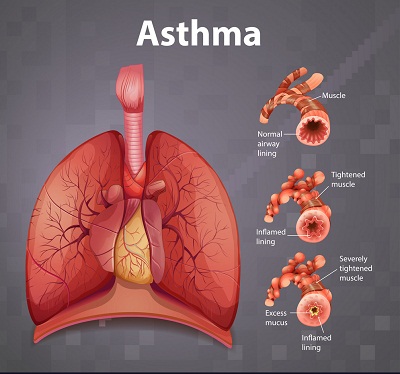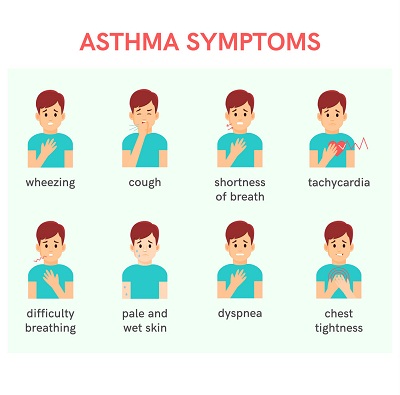Asthma is a disease of airways, which become narrowed and oversensitive to trigger factors. Airway over sensitivity is like leaves of touch me not or ‘chui Mui’ plant. When an asthmatic patient comes in contact with trigger factors such as dust, smoke or pollens, over sensitive airways constrict and patient develops symptoms of Asthma such as cough, wheeze and breathlessness. RHL Lung Center and Asthma Bhawan provides most advanced and the best Asthma treatment in India. Both have advanced diagnostic facilities for asthmatic patients such as advanced spirometry, diffusion test, FeNO testing and induced sputum eosinophil count. In addition to diagnosis, the best quality treatment is available for patients including patient education. Thus, Asthma Bhawan has been rated as the best Asthma Center of Rajasthan and India.
What is Asthma?

What are symptoms of Asthma ?
The most common symptom of asthma is wheezing, a whistling sound made when you breathe. Asthma signs and symptoms include:
- Shortness of breath
- Chest tightness or pain
- Wheezing is a common sign of asthma in children
- Troubled sleep caused by shortness of breath, coughing or wheezing
- Coughing or wheezing attacks that are worsened by a respiratory virus, such as a cold or the flu
For some people, asthma symptoms flare up in certain situations:
- Exercise-induced asthma, which may be worse when the air is cold and dry
- Occupational asthma, triggered by workplace irritants such as chemical fumes, gases or dust
- Allergy-induced asthma, triggered by airborne substances, such as pollen, mold spores, cockroach waste, or particles of skin and dried saliva shed by pets (pet dander)



What are types of Asthma?
- Allergic Asthma (extrinsic asthma)Allergens trigger this common type of asthma. These might include:
- pet dander from animals like cats and dogs
- food
- mold
- pollen
- dust
Allergic asthma is often seasonal because it often goes hand-in-hand with seasonal allergies.
- Nonallergic Asthma (intrinsic asthma)Irritants in the air not related to allergies trigger this type of asthma. These irritants might include:
- burning wood
- cigarette smoke
- cold air
- air pollution
- viral illnesses
- air fresheners
- household cleaning products
- perfumes
- Occupational AsthmaOccupational asthma is a type of asthma induced by triggers in the workplace. These include:
- dust
- dyes
- gases and fumes
- industrial chemicals
- animal proteins
- rubber latex
These irritants can exist in a wide range of occupations, including:
- farming
- textiles
- woodworking
- manufacturing
- Exercise-Induced Bronchoconstriction (EIB)Exercise-induced bronchoconstriction (EIB) usually affects people within a few minutes of starting exercise and up to 10–15 minutes after physical activity. This condition was previously known as exercise-induced asthma (EIA). Up to 90 percent of people with asthma also experience EIB, but not everyone with EIB will have other types of asthma.
- Aspirin-Induced AsthmaAspirin-induced asthma (AIA), also called aspirin-exacerbated respiratory disease (AIA), is usually severe. It is triggered by taking aspirin or another NSAID (nonsteroidal anti-inflammatory drug), such as naproxen (Aleve) or ibuprofen (Advil). Symptoms may aggravate within minutes or hours. Subjects with nasal polyps are at increased risk of getting AERD. About 9 percent of asthmatic patients have AIA. It usually develops suddenly in adults between the ages of 20 and 50.
- Nocturnal AsthmaAsthmatic symptoms worsen at night. Triggers that are thought to bring on symptoms at night include:
- Heartburn or acidity
- pet dander
- dust mites
The body’s natural sleep cycle may also trigger nocturnal asthma.
- Cough-Variant Asthma (CVA)Cough-variant asthma (CVA) does not have classic asthma symptoms of wheezing and shortness of breath. It is characterized by a persistent dry cough. If it is not treated, CVA can lead to full-blown asthma flares that include the other more common symptoms.
What happens during Asthma attack?
An asthma attack starts with exposure to an asthma trigger. Triggers causing asthma attack vary from person to person. There are two types of triggers allergic and non-allergic. Dust, pollens and animal dander are allergic triggers while viral infections, gastrointestinal reflux, air pollution, cigarette smoke, and stress are some of important non-allergic triggers.
When exposed to a trigger factor, the lining of the airways responds by producing chemicals such as histamine and leukotriene. These chemicals are in part responsible for the changes that happen in the lungs during an asthma attack.
The airway lining becomes inflamed and swollen. The production of mucus, normally present in a small amount in the airways, is increased. Typically this results in throat clearing, spitting up phlegm (sputum) and coughing. The muscles wrapped round the bronchioles eventually become constricted or tightened (bronchospasm) and the air passing through the narrowed channels produces a wheeze.
What are symptoms of Asthma attack?
Signs & Symptoms include:
- Severe shortness of breath, chest tightness or pain, and coughing or wheezing
- Low peak expiratory flow (PEF) readings, if you use a peak flow meter
- Symptoms that fail to respond to use of a quick-acting (rescue) inhaler
- severe shortness of breath
- bluish tint to the lips
- low blood pressure (hypotension)
- high or low heart rate
- agitation or confusion
If your asthma symptoms do not improve after you take medication, you may need emergency treatment. Your doctor can help you to learn to recognize an asthma emergency so that you’ll know when to get help
How Asthma is diagnosed?
To diagnose asthma, your doctor will discuss your medical history with you and perform a physical exam. You may need a lung function test and few other tests, such as a chest or sinus X-ray. If you or your child are having breathing problems on a regular basis then visit a doctor. Knowing what to expect during the diagnostic process may help.
Personal and medical history
Your doctor will ask you questions to understand your symptoms and it’s causes. Bring notes to help to jog your memory. Be ready to answer questions about your family history, the medicines you take and your lifestyle. This includes any current physical problems. Shortness of breath, wheezing, coughing and tightness in your chest may show asthma. This also includes all previous medical conditions. A history of allergies or eczema increases your chance of asthma. A family history of asthma, allergies or eczema increases your chance of having asthma, too. Tell your doctor about any home or work exposure to environmental factors that can worsen asthma. For example, these might include pet dander, pollen, dust mites and tobacco smoke. The doctor may also ask if you get chest symptoms when you get a head cold.
Physical exam
If your doctor thinks you have asthma, they will do a physical exam. They will look at your ears, eyes, nose, throat, skin, chest and lungs. This exam may include a lung function test to detect how well you exhale air from your lungs. You may also need an X-ray of your lungs or sinuses. A physical exam then allows your doctor to review your health.
Lung function tests
To confirm asthma, your doctor may have you take one or more breathing tests known as lung function tests. These tests measure your breathing. Lung function tests are often done before and after inhaling a medicine known as a bronchodilator, which opens your airways. If your lung function improves a lot with use of a bronchodilator, you probably have asthma. Your doctor may also prescribe a trial with asthma medicine to see if it helps.
Common lung function tests used to diagnose asthma include:
- Spirometry
- Peak airflow
- FeNO tests (exhaled nitric oxide)
- Provocation tests
How Asthma is treated?
There are two types of medicines reliever and preventer. Reliever relieve agony immediately by bronchodilatation. Salbutamol, theophylline and terbutaline are included in this group. Medicine such as inhaled steroids reduce swelling of bronchial tubes to improve asthma and these prevent asthmatic symptoms. Most of asthmatic medicines are available in oral and inhaled forms. Inhaled forms act quickly have less side effects and are more effective even in very low dose. Therefore inhaled medicines are preferred.
Even though we cannot cure asthma, we can control it. Each case of asthma is different, so you and your doctor need to create an asthma treatment plan just for you. This plan will have information about your asthma triggers and instructions for taking your medicines.
Inhalers – devices that let you breathe in medicine – are the main treatment. Tablets and other treatments may also be needed if your asthma is severe.
You’ll usually create a personal action plan with a doctor.
This includes information about your medicines, how to monitor your condition and what to do if you have an asthma attack.



How asthma attack can be prevented?
- Identify Asthma Triggers
- Stay Away from Allergens
- Avoid Smoke of Any Type
- Prevent Colds
- Allergy-Proof Your Home
- Get Your Vaccinations
- Consider Immunotherapy Allergy Shots
- Take Asthma Medications as Prescribed
- Follow Your Asthma Action Plan
- Use Pink City Flow Meter
